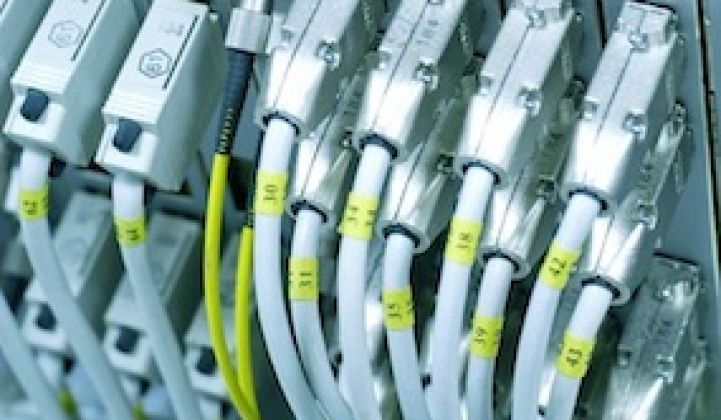The following case study on deploying data analytics comes from GTM Research's latest smart grid report, The Soft Grid 2013-2020: Big Data & Utility Analytics for Smart Grid. In addition to the Oklahoma Gas & Electric's (OGE) data analytics deployment, the report provides case studies on analytics deployment for other leading North American utilities. For more information, click here.
Utilities have been analyzing data for years; from load forecasting to rate design, utilities have traditionally leveraged data for grid operations. That said, the bulk of utilities’ analytics have relied heavily on old technologies like basic spreadsheets, pivot tables, and business intelligence (BI) reports, and have only dealt with a small percentage of the volume and complexity of the data now generated by smart meters and other sensors.
The following case study is an example of what could be termed smart grid 1.0 analytical solutions. These 1.0 deployments can be regarded as both good and bad news. In one sense, it demonstrates that utilities like OGE are moving forward with their plans to put more comprehensive solutions into place, integrating and leveraging the massive smart grid investments which many have already made. On the other hand, some of these first stabs at implementing analytics may begin to look dated in a relatively short period of time, as they are built largely on legacy architectures and technologies which often are not equipped to handle big data and analytics, despite being marketed as such.
UTILITY DATA ANALYTICS CASE STUDY: OKLAHOMA GAS & ELECTRIC (OGE)
OGE's “2020 Initiative” prohibits it from building any new fossil-based generation plants until the year 2020. OGE is looking to fill the gaps via targeted residential and small commercial demand response programs, and is beginning to use dynamic customer segmentation analytics to target best bets.
Analytics Areas
- Consumer analytics and customer segmentation
- Peak load management/load shed (via demand-side management analytics)
- Grid optimization (voltage control and conservation)
- Geospatial and visual analytics for centralized view of multiple systems
OGE’s Challenge
The utility’s chief challenge is to leverage greater value and energy savings out of the 800,000 control points (i.e., smart meters) which were recently rolled out. OGE is also attempting to “break down departmental silos” by implementing a comprehensive and holistic data strategy that will provide the utility with actionable intelligence about its consumers and grid operations.
OGE’s Goal
The utility forecasts daily system demand of 5,864 megawatts in 2020, a reduction of more than 500 megawatts. A reduction of 70 megawatts is slated to take place over the course of 2012, with 60 megawatts being saved via demand response and 10 megawatts via integrated volt/VAR. In order to achieve that ambitious goal, demand response will play a critical role.
Background
OGE is preparing to receive data from 52 million meter reads per day, a figure that is expected to double in the years ahead. One way that OGE is planning to deal with the influx of data is with an integrated operations center that is now in the works, which the utility expects will receive approximately two million event messages per day from advanced metering infrastructure (AMI), data networks, meter alarms and outage management systems. Other areas in which OGE is driving big-data adoption include the planned deployment of a new distribution management system (DMS), as well as an OMS and an integrated volt/VAR control program.
Actions
OGE’s 2020 Initiative will require the utility to shed substantial load. To achieve this goal, the utility has developed a strategy that relies on segmentation analytics, which will allow it to gain visibility into individual customers’ responses to price signals, and as well as to identify the best customers to target with specific marketing campaigns. It will also allow the utility to perform the measurement and verification tasks necessary to develop and offer the most optimal rate structures. The utility’s smart grid investments in both smart meters and ZigBee-controlled thermostats have facilitated this dynamic segmentation capability.
OGE believes that it is important to break down organizational silos because correlations of time-synched data from multiple inputs (MDM, CRM, billing/CIS, asset management and outage management) all provide valuable data that can contribute to the process of developing effective demand response programs and rate structures.
OGE has selected Teradata’s enterprise reporting and analytics solution. The Teradata platform provides the backbone for smart meter data, and also helps the utility gain a clearer understanding of customer behaviors and preferences from an enterprise perspective.
OGE: Three Levels of Information Architecture
OGE’s approach to information architecture is quite similar to the model presented in GTM Research's soft grid taxonomy. A data warehouse serves as Layer 1, improved and expanded data integration and data management serves as Layer 2, and new analytics and presentation capabilities serve as the top layer (Layer 3).
The utility’s data warehouse is engineered to expand to accommodate hundreds of terabytes of data over the next two years. Its data integration and management layer will be improved by real-time messaging. Outputs from the new system will be configured so that employees with access will get a live look at a near-real-time version of the data; this solves the dreaded versioning problems that are widespread in the utility industry. While the analytics layer is still relatively new, the utility reports that the experience thus far has been a positive one. OGE is particularly impressed with the capabilities of its geospatial and visual analytics, which has granted the utility a new look at its assets.
In addition to OGE's case study above, The Soft Grid 2013-2020: Big Data & Utility Analytics for Smart Grid includes data analytics deployment analysis for Burlington Hydro, CenterPoint Energy, Florida Power & Light (FPL), Oncor, PECO, San Diego Gas & Electric (SDG&E), and Southern California Edison (SCE). For more information, click here.



